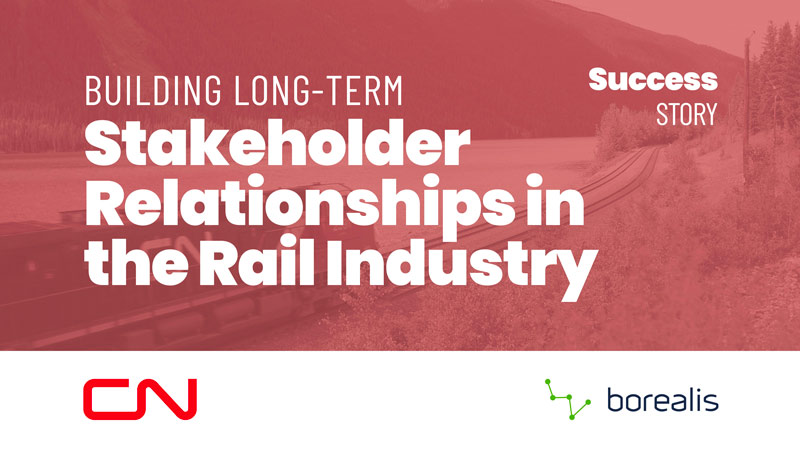Any business that wants to carry projects through to successful completion needs to manage stakeholders closely. Organizations around the world rely on our Borealis stakeholder management software to manage their stakeholders more effectively to secure social license and ensure project success.
Tap into our stakeholder management expertise with this article, which looks looks at what is a stakeholder, the importance of stakeholders, and which stakeholder groups your business may need to engage with. We also cover how different stakeholder groups may impact – or be impacted by – your project, as well as how their needs may vary with this article.
As a bonus, we’ve included concrete examples of how specific industries are improving stakeholder relationships by identifying their needs and addressing them appropriately.
What is a stakeholder?
A stakeholder is any individual, group, or organization that can impact or is impacted by an organization’s actions, policies, and decisions. Stakeholders can be categorized into two main groups:
- Internal stakeholders: Individuals or groups within an organization, such as employees, management, and shareholders
- External stakeholders: Individuals or groups outside the organization, such as customers, suppliers, government agencies, and the community
Stakeholders can be further classified by level of interest and power:
- High-interest stakeholders: Those who have a vested interest in the organization’s success or failure and are more likely to engage with the organization
- High-power stakeholders: Those who can influence the organization’s decisions or operations.
Understanding these stakeholder categories can help organizations prioritize their stakeholder engagement efforts to achieve project goals more efficiently.
Importance of stakeholders
Learning what is a stakeholder automatically comes with learning why they are crucial to a project success. Organizations cannot underestimate the importance of stakeholders as they can provide the resources, support, and influence needed to ensure project success.
Here are some examples of stakeholder groups and why they might be of importance to an organization:
- Employees provide the labor and skills the organization needs to operate. Tjeu can contribute to the development of new products and services, improve customer satisfaction, and enhance the organization’s reputation.
- Customers are the primary source of revenue for most organizations. Meeting their needs and expectations is critical, as customers have a choice in where they spend their money. A satisfied customer can become a loyal customer and even a brand ambassador, contributing to the organization’s long-term success.
- Suppliers provide the goods and services the organization needs to operate smoothly. Building strong relationships with suppliers can give an organization access to the resources and expertise it needs to improve its products and services.
- Shareholders & financial lenders invest in the organization and expect a return on their investment. Increasingly, they expect organizations to adhere to environmental, social, and governance practices. Meeting shareholder expectations can help an organization secure additional funding and support.
- See IFC’s Stakeholder Engagement: A Good Practice Handbook for Companies Doing Business in Emerging Markets >
- Government officials can enact regulations that impact the organization’s operations.
- Community members can advocate for or against an organization’s activities.
By engaging effectively with these and other key stakeholder groups, organizations can mitigate risks and enhance their reputation.
Stakeholder capitalism
Stakeholder capitalism is a term that has been coined more recently that also supports this importance of stakeholders. Stakeholder capitalism is an economic system and business philosophy that emphasizes the importance of considering the interests of all stakeholders in a company, rather than solely focusing on maximizing shareholder value. In this approach, businesses prioritize not only their shareholders but also their employees, customers, suppliers, communities, and the environment.
The goal of stakeholder capitalism is to create long-term value and sustainable growth for all parties by aligning business objectives with social and environmental responsibilities. This model promotes more inclusive and equitable outcomes, fostering collaboration and cooperation among diverse groups for the common good
How stakeholder can improve business outcomes
Stakeholder relationships can be directly correlated to business outcomes. Organizations that strive to maintain positive relationships regularly engage with stakeholders in an open and transparent manner. As a result, they are better able to identify and address stakeholder concerns, and thereby build trust and improve their reputation.
Businesses that need to manage many stakeholders, carry out multi-phase/long-term projects or comply with regulations regarding stakeholder relation, will often invest in a stakeholder relationship management (SRM) system like Borealis to manage these relationships more effectively. SRM software centralizes all stakeholder data and creates a lasting corporate memory that teams can refer to over the project’s lifespan. As team members come and go, the valuable information remains.
When reaching higher level of data management maturity, organizations are able obtain better insights from their stakeholder data which in turns contribute to:
- Provide valuable insights
- Enhance reputation
- Facilitate innovation
- Ensure compliance and risk management
- Supportlong-term sustainability
- Provid access to resources and networks
- Enhance decision-making
- Strengthen customer relationships
- Improve employee engagement
- Resolve conflicts
How to identify stakeholders
Identifying stakeholders is usualy the first step of any stakeholder engagement strategy. Various techniques can be used to identify stakeholders.
Below are just some examples:
- Brainstorming can be used at multiple points throughout a project to create an exahaustive list of potential stakeholders. The more people involved in the brainstorming, the less likely key stakeholder groups will be overlooked.
- Organizational documents, such as project documents, organizational charts, strategic plans, and other relevant materials, can be reviewed to identify stakeholders mentioned or implied.
- Experts can be consulted, such as subject matter experts, industry leaders, and peers in similar organizations, to gain insights on potential stakeholders and their importance.
- GIS technology can be used to overlay information from your land management team (like, parcels, Shapefiles, etc.) on your stakeholder database to easily see who is in the vicinity of the project that you need to engage with,
- Interviews and surveys can be conduced with with key individuals within the organization and externally to gather their perspectives on who the most important stakeholders are.
- Social media and online forums can be monitored to track conversations happening around your organization, industry, and projects to identify individuals and groups who express strong opinions or concerns.
- Regulatory and compliance requirements can be reviewed, such as relevant laws, regulations, and industry standards to identify stakeholders who must be considered due to legal or compliance obligations.
- Workshops or focus groups can be held to facilitate structured discussions with a diverse group of participants to gather insights on stakeholder identification and priorities.
Once all stakeholders have been identified, a stakeholder analysis can be conducted to assess and prioritize their importance in terms of power and interest. A stakeholder relationship network can also be charted to understand the interconnected relationships between stakeholders at play. These insights can then be used to inform your stakeholder engagement plan.
Examples of Stakeholder Groups
Organizations typically need to manage different stakeholder groups using different approaches and tools. For example, employee relationships can be managed with Environment, Health & Safety (HSE) software or employee engagement plateforms, while customers are best managed with customer relationship management (CRM) software.
Let’s look at the various stakeholder groups best managed with a fit-for-purpose stakeholder management software like Borealis.
Stakeholders that can influence your project
Below are some of the stakeholder groups a business must identify and engage with throughout a project’s lifecycle to address concerns, manage risks, and build trust to increase the likelihood of project success.
- Suppliers and vendors that provide essential goods, services, or resources required for the project’s completion.
- Investors and financial institutions that provide funding or financial support for the project, and who expect returns on their investment. See strategies for simplifying investor relationship management >
- Partners and collaborators involved in joint ventures or cooperative agreements related to the project.
- Regulators and government agencies responsible for creating and enforcing laws, regulations, and industry standards that the project must comply with.
- Industry associations and professional bodies that represent and advocate for the interests of businesses and professionals within the industry.
- Local communities who have a vested interest in the project’s activities or outcomes.
- Media and public opinion that can impact the project’s reputation and success.
- Non-governmental organizations (NGOs) and advocacy groups: Organizations that represent specific causes or interests and that may campaign for or against the project based on their values.
Stakeholders that can be impacted by your project
A business’s projects can have positive or negative impacts on different stakeholder groups. This depends on the nature of the project and how it is executed. Here are some common stakeholder groups that can be affected by a business’s projects:
- Suppliers and vendors can be impacted by your projects because it can lead to changes in demand for specific goods and services, impacting supplier relationships, contracts, and revenue.
- Local communities might experience collateral effects of your project such as job creation, environmental changes, or disruptions to local infrastructure and services.
- Environmental justice communities can be disproportionately impacted by projects since, historically at least, these low-income, minority, or marginalized groups were found to have with limited resources and political power to safeguard their interests, particularly when it comes to a project’s environmental hazards or pollution.
- Land owners are the typical impacted stakeholders in a project that entails land acquisition, change land use, impact land esthetics and access, property values, lead to environmental changes, etc. In some cases, it might even mean resettlement.
- Neighboring businesses can be affected since construction projects often cause disruptions, affecting pedestrian an vehicle traffic. Noise, pollution, and environmental impacts are other issues that might affect local businesses. Finaly, projects may also influence resource availability and infrastructure access for those business stakeholders.
- Indigenous communities are communities that have unique ties to ancestral lands. Projects can affect land rights, cultural preservation, the practice of traditional activities, and have economic, health, and social impacts.
Examples of effective stakeholder management by industry sector
Mining
Yamana Gold is a Canadian-based gold producer focused on mining exploration and development in South America. It proactively manages stakeholder-related risks and community issues to build a stronger social license to operate in Argentina.

Gas

Rail
What are the needs of stakeholders
To manage stakeholders effectively, an organization must understand their needs and expectations. Stakeholder needs can vary depending on:
- Category
- Level of interest and power
- Industry or environment the organization operates in
Stakeholder needs in infrastructure and energy projects
Infrastructure projects are large-scale projects that involve the development of physical infrastructure such as roads, bridges, airports, and public transportation systems. These projects often have a significant impact on the surrounding communities and stakeholders.
Understanding and meeting the needs of these stakeholders is critical to the success of infrastructure projects. Here are some examples of stakeholder needs in infrastructure projects:
- Community members expect infrastructure that improves the quality of life, brings economic opportunities, and provides safe and efficient transportation. To meet these needs, infrastructure projects must be designed with community input and consideration.
- How to meet these needs: For example, a new highway project can involve community engagement to determine the best route and address any concerns regarding noise, pollution, or disruption to local businesses.
- Environmental groups want sustainable infrastructure projects with minimal environmental impacts. These groups may be concerned about the potential impact on air and water quality, wildlife habitats, and natural resources.
- How to meet these needs: Infrastructure projects can incorporate sustainable design principles and technologies, such as green roofs or solar panels, that reduce their carbon footprint.
- Government agencies expect infrastructure projects to meet regulatory requirements and contribute to local/regional/national development. These agencies may be responsible for funding, permitting, or overseeing the construction of infrastructure projects.
- How to meet these needs: Infrastructure projects can adhere to regulations and provide clear communication and collaboration with government agencies throughout the project lifecycle.
- Contractors and suppliers want infrastructure projects that provide fair and competitive bidding processes, timely payments, and safe working conditions.
- How to meet these needs: Infrastructure projects can implement ethical and transparent procurement processes and prioritize worker safety throughout the construction process.
Understanding stakeholder needs requires regular engagement and communication. These interactions can multiply very quickly in large-scale projects involving many stakeholders. Organizations need to have a high data maturity level to manage and track all these interactions in a structured and efficient manner. Otherwise, all this vital information simply becomes noise.
Businesses in the energy sector often come to us to learn about stakeholder relationships management tools that can help efficiently manage large quantities of stakeholder data and drive infrastructure project success.
Stakeholder needs in governmental agencies
Stakeholders of government are individuals or groups that have an interest in or are affected by government decisions and actions. These stakeholders play a critical role in shaping government policy and programs, and their needs and expectations must be taken into account to ensure effective governance.
The needs of these stakeholders can vary widely depending on their interests, priorities, and perspectives. Some may be primarily concerned with economic growth and job creation, while others may prioritize social welfare programs and the protection of civil liberties. Here are a few examples of the needs and expectations of different stakeholder groups:
- Citizens are the primary beneficiaries of government services, and expect governments to provide essential services such as healthcare, education, and public safety. They also expect governments to be transparent, accountable, and responsive to their needs and concerns.
- Businesses rely on government policies to create a stable and predictable economic environment that supports growth and innovation. They may seek tax incentives, subsidies, and deregulation to reduce costs and improve profitability.
- NGOs often advocate for the rights of marginalized and vulnerable groups, such as refugees, the homeless, and those living in poverty. They may call on governments to fund social welfare programs and protect human rights.
- Labor unions represent the interests of workers and may push for policies that protect workers’ rights, such as minimum wage laws, workplace safety regulations, and collective bargaining rights.
- Environmental advocates may seek government regulations and policies that protect the environment and address climate change. They may push for initiatives such as renewable energy development, pollution controls, and conservation efforts.
- Law enforcement agencies rely on government support to provide adequate resources and training to maintain public safety. They may also advocate for policies that address issues such as gun control, immigration, and national security.
How to meet those needs: To effectively serve these and other stakeholders, governments must engage in regular and transparent communication, prioritize stakeholder engagement, and make informed decisions based on stakeholder feedback and input.
Stakeholder needs in health organizations
Stakeholders of health businesses and organizations are individuals or groups who have an interest in or are affected by the decisions and actions of the organization. To ensure effective management of health businesses and organizations, it is essential to understand the needs of the following stakeholders.
- Patients are the primary beneficiaries of healthcare services and their needs are central to the functioning of healthcare organizations. Patients expect high-quality care, timely access to medical services, and transparent communication with healthcare providers. They also expect that their privacy will be protected and that they will receive compassionate and respectful care.
- Healthcare providers, including physicians, nurses, and other medical professionals, are essential stakeholders in healthcare organizations. They require a supportive work environment, appropriate compensation, and access to the latest medical technology and research. They also need training and education opportunities to maintain their skills and stay up to date with best practices.
- Employees, namely their dedication and productivity, are at the heart of a healthcare organization’s success. Employees require a safe and healthy work environment, opportunities for professional development and growth, and fair compensation.
- Donors provide financial support to healthcare organizations. They expect organizations to be transparent, accountable, responsible and ethical in how they manage their donations. They want to be informed of the impacts of their donations through regular communications. Some may also expect recognition.
- Regulatory agencies oversee healthcare organizations and ensure that they adhere to legal and ethical standards. They require compliance with applicable laws and regulations, transparency in decision-making processes, and effective management of risk.
Why should stakeholders be managed differently than customers
Stakeholders and customers have different roles, interests, and influences on an organization. Stakeholder management focuses on communication, engagement, and long-term relationships, while customer management emphasizes product or service quality and satisfaction. Managing these groups differently is crucial for addressing their unique needs and ensuring organizational success.
The tools used to manage these distinct groups also differ. Customers are usually managed with customer relationship management (CRM) software, while project stakeholders are usually managed with stakeholder relationship management (SRM) software.
Conclusion
You now know what are stakeholders, why stakeholders are important, and how to identify stakeholders and evaluate their needs. You’re now ready to move on to the next step of the stakeholder management journey: conducting a stakeholder analysis and mapping project stakeholders.






